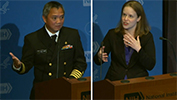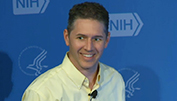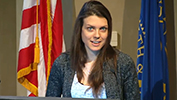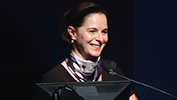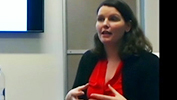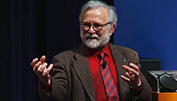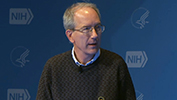-
- NIH VideoCast - Patient and Observer Reported Outcomes: Innovations and Applications in Fatigue and Suicide Risk
-
- - Leorey Saligan, PhD, RN, CRNP, FAAN Tenure-Track Investigator, Symptoms Management Branch, NINR, NIH and Elizabeth Ballard, PhD Staff Scientist, Experimental Therapeutics and Pathophysiology Branch, NIMH, NIH (2017/05/05)
- - Category : Clinical Center Grand Rounds
- CC Grand Rounds
Patient and Observer Reported Outcomes: Innovations and Applications in Fatigue and Suicide Risk
For more information go to http://www.cc.nih.gov/about/news/grcurrent.html
NIH VideoCast - Patient and Observer Reported Outcomes: Innovations and Applications in Fatigue and Suicide Risk
-
- NIH VideoCast - ODP Early-Stage Investigator Award Winners lectures - May 2017
-
- - Justin C. Brown, Ph.D. and Katherine Keyes, Ph.D., M.P.H. (2017/05/05)
- - Category : Special
- The Office of Disease Prevention (ODP) is pleased to announce the 2017 winners of the inaugural annual ODP Early-Stage Investigator Award. The award recognizes early-career prevention scientists who have not competed successfully for a substantial NIH-supported research project, but who have already made significant, outstanding research contributions to their respective fields and are poised to become future leaders in prevention research.
The winners will give presentations at the National Institutes of Health (NIH), directly preceding the Robert S. Gordon, Jr. Lecture in Epidemiology.
NIH VideoCast - ODP Early-Stage Investigator Award Winners lectures - May 2017
-
- NIH VideoCast - The changing epidemiology of HPV and cervical cancer: from etiology, to validation of prevention methods, to dissemination
-
- - Mark Schiffman, M.D., M.P.H., Senior Investigator, NCI, NIH (2017/05/05)
- - Category : WALS - Wednesday Afternoon Lectures
- NIH Director`s Wednesday Afternoon Lecture Series
Over three decades of studies moving from etiology to preventive methods research to guidelines development, Dr. Schiffman has learned some broad lessons about the strengths and weaknesses of epidemiology that he will describe.
He joined the Clinical Genetics Branch in October 2009 to study intensively why HPV is such a powerful carcinogenic exposure, akin to an acquired genetic trait with high penetrance for a cancer phenotype. The main studies in which Dr. Schiffman played a major role in the past 5 years, listed chronologically, include: The Portland Kaiser Cohort; the Taiwan Cohort Study; the Guanacaste Natural History Study; the ASCUS-LSIL Triage Study (ALTS); the Study to Understand Cervical Cancer Early Endpoints and Determinants (SUCCEED/Biopsy); the Costa Rica Vaccine Trial (CVT); the Persistence and Progression (PaP) Study; and Nigeria Project Itoju. These studies overall have related HPV status to outcome for more than 100,000 women.
For more information go to https://oir.nih.gov/wals/2016-2017/changing-epidemiology-hpv-cervical-cancer-etiology-validation-prevention
NIH VideoCast - The changing epidemiology of HPV and cervical cancer: from etiology, to validation of prevention methods, to dissemination
-
- NIH VideoCast - T follicular helper cells (Tfh) and B cell responses in the context of vaccines and infections
-
- - Shane Crotty, Ph.D., Professor, Division of Vaccine Discovery, La Jolla Institute For Allergy and Immunology (2017/05/05)
- - Category : Immunology
- Immunology Interest Group Seminar Series
Dr. Crotty has made fundamental contributions to the study of vaccine responses, including studies that helped define factors contributing to vaccine effectiveness including establishing that follicular T helper cells are a distinct type of differentiated CD4 T cell uniquely specialized in B cell help. He will speak on T follicular helper cells (Tfh) and their control of B cell responses in the context of vaccines and infections.
Dr. Shane Crotty is an internationally recognized leader in the field of T follicular helper cells (Tfh cells) and vaccine biology. Dr. Crotty received a double B.S. in both Biology and Writing from the Massachusetts Institute of Technology (MIT) in 1996. During his PhD at UCSF, he discovered the mechanism of action of the antiviral drug ribavirin, a drug frequently used to treat chronic hepatitis C. In his postdoctoral work with Rafi Ahmed, Dr. Crotty went on to make seminal discoveries about germinal center formation, vaccine responses and the development of effective longterm antibodies. His work ranged from the demonstration of the role of the adaptor molecule SAP in germinal center formation, to studies on the duration of responses to small pox vaccination in humans. In 2003, he joined the faculty at the La Jolla Institute, where he has continued to make fundamental contributions to the study of vaccine responses, including studies that helped establish that Tfh cells are a distinct type of differentiated CD4 T cell uniquely specialized in B cell help, and that Tfh differentiation is controlled by the transcription factor Bcl6. His work has also helped characterize Tfh responses in humans during HIV infection and in response to vaccination. Dr. Crotty has been named a Pew Scholar and has received the American Association of Immunologists (AAI) B-D Investigator Award for outstanding early-career research contributions to the field of Immunology. Finally, he is also the author of Ahead of the Curve, a biography of Nobel laureate scientist David Baltimore, published in 2001, attesting to his wide-range of skills. His lecture will present some of his newest exciting findings on Tfh and B cell responses to vaccines.
NIH VideoCast - T follicular helper cells (Tfh) and B cell responses in the context of vaccines and infections
-
- NIH VideoCast - JATS-Con 2017 (Day 1)
-
- - NCBI, NLM, NIH (2017/05/04)
- - Category : Conferences
- JATS-Con is a user meeting for NISO Z39-96: Journal Article Tag Suite.
For more information go to https://jats.nlm.nih.gov/jats-con
NIH VideoCast - JATS-Con 2017 (Day 1)
-
- NIH VideoCast - Interagency Autism Coordinating Comittee - April 2017
-
- - NIH (2017/05/04)
- - Category : Interagency Autism Coordinating Committee
- This is the 2nd quarter meeting of the Interagency Autism Coordinating Committee
For more information go to https://iacc.hhs.gov
NIH VideoCast - Interagency Autism Coordinating Comittee - April 2017
-
- NIH VideoCast - Clinical Center Research Hospital Board - April 2017
-
- - Office of the Director, NIH (2017/05/03)
- - Category : Advisory Board Meetings and Workshops
- Clinical Center Research Hospital Board Meeting
For more information go to https://ccrhb.od.nih.gov/charter.htm
NIH VideoCast - Clinical Center Research Hospital Board - April 2017
-
- NIH VideoCast - Interactions between Memory and Decision Systems of the Brain
-
- - Sheri J.Y. Mizumori, Ph.D., Professor and Chair, Department of Psychology, University of Washington (2017/05/03)
- - Category : Neuroscience
- NIH Neuroscience Series Seminar
Understanding the mechanisms of neuroplasticity as related to learning and memory is fundamental to our understanding of the causes of a variety of cognitive disorders as well as the developmental changes in learning that occur across the lifespan. Dr. Mizumori???s laboratory attempts to address these issues by using a rodent model of spatial navigation to investigate the dynamic responses of single neurons in the brain, as well as the complex interactions between cells located in different memory-related structures. These studies employ techniques involving recording extracellular signals from many cells simultaneously as animals perform memory tasks. Their studies have examined many processes that contribute to successful and adaptive navigation: 1) the evaluation of sensory input during active locomotion, 2) the integration of current sensory information with past knowledge about an environment, and with internal state information, and 3) the behavioral implementation of highly processed spatial information. More recently, they have been considering these processes in terms of the flexibility of underlying neural representational systems during shifts in cognitive strategy or task demands. They are particularly interested in the role of neuromodulators such as dopamine in flexible memory function.
For more information go to https://neuroscience.nih.gov/neuroseries/Home.aspx
NIH VideoCast - Interactions between Memory and Decision Systems of the Brain
-
- NIH VideoCast - Attention Deficit Hyperactivity Disorder: From Causes to Treatment
-
- - 1) Maximilian Muenke, MD, Senior Investigator and Chief, Medical Genetics Branch, NHGRI, NIH and Director, NIH Medical Genetics and Genomic Medicine Residency and Fellowship Programs and 2) Philip Shaw, BM BCh, PhD Investigator, Social and Behavioral Research Branch, NHGRI, NIH (2017/05/02)
- - Category : Clinical Center Grand Rounds
- CC Grand Rounds
Attention Deficit Hyperactivity Disorder: From Causes to Treatment
For more information go to http://www.cc.nih.gov/about/news/grcurrent.html
NIH VideoCast - Attention Deficit Hyperactivity Disorder: From Causes to Treatment
-
- NIH VideoCast - The primary shield: role of our microbes in heath and diseases
-
- - Yasmine Belkaid, Ph.D., Director, Microbiome Program, Chief of the Mucosal Immunology Section, Laboratory of Parasitic Diseases, National Institute of Allergy and Infectious Diseases, NIH (2017/04/29)
- - Category : WALS - Wednesday Afternoon Lectures
- NIH Director???s Wednesday Afternoon Lecture Series
The microbiota plays a fundamental role in the induction, education and function of the host immune system. In return, the host immune system has evolved multiple means by which to maintain its symbiotic relationship with the microbiota. The maintenance of this dialogue allows the induction of protective responses to pathogens and the utilization of regulatory pathways involved in the sustained tolerance to innocuous antigens. The ability of microbes to set the immunological tone of tissues, both locally and systemically, requires tonic sensing of microbes and complex feedback loops between innate and adaptive components of the immune system. Dr. Belkaid will discuss some of the dominant mediators of these interactions and discuss emerging themes associated with our current understanding of the immunological dialogue between the host and its microbiota in health and diseases.
Dr. Belkaid work explores the field of immune regulation and has defined fundamental mechanisms that regulate tissue homeostasis and host immune responses. Her work uncovered key roles for the commensal microbiota and dietary factors in the maintenance of tissue immunity and protection to pathogens.
NIH VideoCast - The primary shield: role of our microbes in heath and diseases
-
- NIH VideoCast - Symptom Science Research: A Path to precision Health
-
- - Patrica Grady, NIH, Ann Cashion, NIH, Michael Gottesman, NIH, Jessica Gill, NIH, Leo Saligan, NIH and Wendy Henderson, NIH (2017/04/27)
- - Category : Conferences
- NINR Director Symposium
The Intramural Research Program at the National Institute of Nursing Research (NINR), invites you to attend the scientific symposium, Symptom Science Research: A Path to Precision Health. The symposium will highlight NINR Intramural???s scientific advances and collaborations across the National Institutes of Health (NIH) and other organizations.
NIH VideoCast - Symptom Science Research: A Path to precision Health
-
- NIH VideoCast - 10th Matilda White Riley Behavioral and Social Sciences Honors
-
- - Office of Behavioral and Social Sciences Research, NIH (2017/04/27)
- - Category : Conferences
- Every year, OBSSR honors the research trajectory and continuing influence of Dr. Matilda White Riley in the behavioral and social sciences across and beyond the National Institutes of Health (NIH). In 2016, OBSSR has turned the celebration into the Real Life, Labs, Research.
For more information go to https://obssr.od.nih.gov/events/matilda-white-riley-lecture/the-10th-matilda-white-riley-behavioral-and-social-sciences-day-mwrday2017
NIH VideoCast - 10th Matilda White Riley Behavioral and Social Sciences Honors
-
- NIH VideoCast - Demystifying Medicine 2017: Addison???s Disease meets Chromatin Biology
-
- - Lynnette Nieman, MD, NICHD, NIH and Daniel Larson, PhD, NCI, NIH (2017/04/27)
- - Category : Demystifying Medicine
- The Demystifying Medicine Lecture Series is designed to help bridge the gap between advances in biology and their applications to major human diseases. Each lecture will feature a presentation on a major disease, including current research and advancements on treatments.
For more information go to https://demystifyingmedicine.od.nih.gov
NIH VideoCast - Demystifying Medicine 2017: Addison???s Disease meets Chromatin Biology
-
- NIH VideoCast - As One Project Movie Screaning
-
- - NIMH, NIH (2017/04/27)
- - Category : Special
- The office of Autism Research Coordination will show the movie called As One Project and have panel discussion to screen the movie. This event will be hosted for the April Autism Awareness Month.
NIH VideoCast - As One Project Movie Screaning
-
- NIH VideoCast - Laser micro-irradiation to monitor single strand break repair
-
- - Dr. Natalie Gassman, University of South Alabama (2017/04/25)
- - Category : DNA Repair
- DNA repair videoconference
NIH VideoCast - Laser micro-irradiation to monitor single strand break repair
-
- NIH VideoCast - Multifaceted Functions of Mitochondria in Neuronal Synapses
-
- - Zheng Li, Ph.D., Principal Investigator, Section on Synapse Development Plasticity, Clinical Brain Disorders Branch, NIMH, NIH (2017/04/25)
- - Category : NIH Director`s Seminars
- Director`s Seminar Series
The Section on Synapse Development and Synaptic Plasticity led by Dr. Zheng Li is interested in the molecular and cellular mechanisms underlying synapse development and synaptic plasticity in normal brains and synaptopathology associated with psychiatric disorders. Our research shows that mitochondria, the vital organelles in eukaryotic cells, not only are essential for the general cell physiology, but also play multifaceted roles in synapses. In hippocampal neurons, the quantify of mitochondria in dendrites determines the density of synapses and dendritic spines. Mitochondria are permeabilized upon activation of NMDA receptors to release cytochrome c, which activates caspases to promote AMPA receptor endocytosis and long-term synaptic depression. Mitochondrial fission is induced when neurons are stimulated at gamma range (30-80 Hz) frequencies, which leads to translocation of mitochondria to synapses, and mitochondria fission is required for the maintenance of gamma oscillation, synchronized neural activities involved in cognitive processing and impaired in schizophrenia patients. Moreover, we found that dysbindin-1, a protein encoded by the schizophrenia risk gene DTNBP1 is required for mitochondrial fission during gamma oscillation, and that deficient dysbindin-1 in mice leads to inhibition of gamma oscillation. Dysbindin-1, therefore, may contribute to the cognitive impairment of schizophrenia patients by regulating mitochondrial fission and gamma oscillation. These findings demonstrate that mitochondria are important for the development, plasticity and pathology of synapses.
NIH VideoCast - Multifaceted Functions of Mitochondria in Neuronal Synapses
-
- NIH VideoCast - From protein folding to cognition: a serendipitous path of discovery
-
- - Peter Walter, Ph.D., Distinguished Professor of Biochemistry and Biophysics at University of California, San Francisco; Investigator, Howard Hughes Medical Institute (2017/04/21)
- - Category : WALS - Wednesday Afternoon Lectures
- NIH Director???s Wednesday Afternoon Lecture Series
A screen for small-molecule modulators of the unfolded protein response yielded ISRIB, a drug-like compound that with high efficacy renders cells insensitive to translational inhibition by phosphorylation of eIF2. ISRIB is an activator of eIF2B, eIF2`s guanine nucleotide exchange factor, and a cognitive enhancer in rodents, significantly improving long-term memory of wild-type animals in behavioral assays.
Dr. Walter is the winner of the 2014 Lasker Award, 2014 Shaw Prize, and 2015 Vilcek Prize.
NIH VideoCast - From protein folding to cognition: a serendipitous path of discovery
-
- NIH VideoCast - Hijacking of immune regulatory mechanisms in lymphoid malignancies
-
- - Louis M. Staudt, MD, PhD, NCI, NIH (2017/04/21)
- - Category : Immunology
- Immunology Interest Group Seminar Series
Signalling through the B cell receptor (BCR) is central to the development and maintenance of B cells. In light of the numerous proliferative and survival pathways activated downstream of the BCR, it comes as no surprise that malignant B cells would co-opt this receptor to promote their own growth and survival. However, direct evidence for BCR signalling in human lymphoma has only come to light recently. Roles for antigen-dependent and antigen-independent, or tonic, BCR signalling have now been described for several different lymphoma subtypes. Furthermore, correlative data implicate antigen-dependent BCR signalling in many other forms of lymphoma. A host of therapeutic agents targeting effectors of the BCR signalling pathway are now in clinical trials and have shown initial success against multiple forms of lymphoma.
Dr. Staudt received his B.A. from Harvard College and his M.D. and Ph.D. degrees from the University of Pennsylvania School of Medicine. Following Internal Medicine training, he joined Nobel Laureate David Baltimore`s laboratory at the Whitehead Institute as a Jane Coffin Childs postdoctoral fellow. In 1988, he established his laboratory at the National Cancer Institute (NCI), which focuses on the molecular basis for human lymphoid malignancies and the development of targeted therapies for these cancers. Dr. Staudt is Co-Chief of the Lymphoid Malignancies Branch and Director of the NCI Center for Cancer Genomics, which oversees large-scale programs studying the genomic aberrations in cancer. He has received numerous awards for his research, including the 2009 Dameshek Prize from the American Society of Hematology, the 2015 San Salvatore Prize, the 2016 C. Chester Stock Award Lectureship from Memorial Sloan Kettering Cancer Center, the 2017 Princess Takamatsu Memorial Award from the American Association for Cancer Research, and election to the National Academy of Sciences in 2013.
NIH VideoCast - Hijacking of immune regulatory mechanisms in lymphoid malignancies
-
- NIH VideoCast - The split personality of human O-GlcNAc transferase
-
- - Suzanne Walker, Ph.D., Professor of Microbiology and Immunobiology, Harvard Medical School (2017/04/20)
- - Category : WALS - Wednesday Afternoon Lectures
- NIH Director???s Wednesday Afternoon Lecture Series
O-GlcNAc Transferase (OGT) is a glycosyltransferase essential for the viability of most multicellular organisms, including mammals. It catalyzes the attachment of N-acetylglucosamine (GlcNAc) to serines and threonines of nuclear and cytoplasmic proteins, resulting in changes in protein localization, stability, and interactions. Protein O-GlcNAc levels are responsive to cellular glucose concentration, and chronically elevated O-GlcNAc levels are observed in both cancer and diabetes and are associated with widespread changes in gene expression. While the importance of OGT in the biology of multicellular organisms is clear, the molecular mechanisms underlying its effects remain poorly understood. Recently, OGT was reported to catalyze another post-translational modification: the cleavage of the essential cell-cycle regulator host cell factor 1 (HCF-1). Cleavage is required for proper HCF-1 function.
Dr. Walker`s laboratory has been working on the chemistry of OGT in order to lay the groundwork for exploring its biology. For her lecture, Dr. Walker will talk about her lab`s structural work on OGT and describe what we have learned about the mechanism of O-GlcNAcylation and HCF-1 cleavage. She will also describe the development of cell-permeable OGT inhibitors and show how they bind to the enzyme. Finally, she will touch on how her lab`s biochemical studies have provided information that may allow us to address a key question: Why is OGT essential for the viability of all dividing mammalian cells?
NIH VideoCast - The split personality of human O-GlcNAc transferase
-
- NIH VideoCast - Demystifying Medicine 2017: Bioengineering: Bridging Brain, Computer, and Neurologic Disease
-
- - Jonathan Wolpaw, MD, National Center for Adaptive Neurotechnologies (2017/04/20)
- - Category : Demystifying Medicine
- The Demystifying Medicine Lecture Series is designed to help bridge the gap between advances in biology and their applications to major human diseases. Each lecture will feature a presentation on a major disease, including current research and advancements on treatments.
For more information go to https://demystifyingmedicine.od.nih.gov
NIH VideoCast - Demystifying Medicine 2017: Bioengineering: Bridging Brain, Computer, and Neurologic Disease



